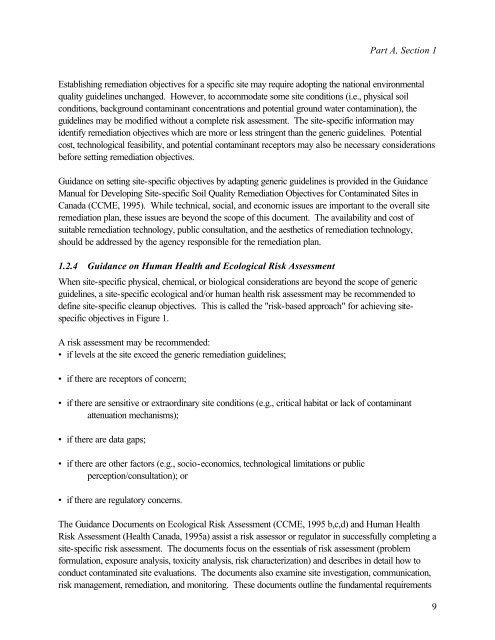Protocol for the Derivation of Environmental and Human ... - CCME
Protocol for the Derivation of Environmental and Human ... - CCME
Protocol for the Derivation of Environmental and Human ... - CCME
You also want an ePaper? Increase the reach of your titles
YUMPU automatically turns print PDFs into web optimized ePapers that Google loves.
Part A, Section 1<br />
Establishing remediation objectives <strong>for</strong> a specific site may require adopting <strong>the</strong> national environmental<br />
quality guidelines unchanged. However, to accommodate some site conditions (i.e., physical soil<br />
conditions, background contaminant concentrations <strong>and</strong> potential ground water contamination), <strong>the</strong><br />
guidelines may be modified without a complete risk assessment. The site-specific in<strong>for</strong>mation may<br />
identify remediation objectives which are more or less stringent than <strong>the</strong> generic guidelines. Potential<br />
cost, technological feasibility, <strong>and</strong> potential contaminant receptors may also be necessary considerations<br />
be<strong>for</strong>e setting remediation objectives.<br />
Guidance on setting site-specific objectives by adapting generic guidelines is provided in <strong>the</strong> Guidance<br />
Manual <strong>for</strong> Developing Site-specific Soil Quality Remediation Objectives <strong>for</strong> Contaminated Sites in<br />
Canada (<strong>CCME</strong>, 1995). While technical, social, <strong>and</strong> economic issues are important to <strong>the</strong> overall site<br />
remediation plan, <strong>the</strong>se issues are beyond <strong>the</strong> scope <strong>of</strong> this document. The availability <strong>and</strong> cost <strong>of</strong><br />
suitable remediation technology, public consultation, <strong>and</strong> <strong>the</strong> aes<strong>the</strong>tics <strong>of</strong> remediation technology,<br />
should be addressed by <strong>the</strong> agency responsible <strong>for</strong> <strong>the</strong> remediation plan.<br />
1.2.4 Guidance on <strong>Human</strong> Health <strong>and</strong> Ecological Risk Assessment<br />
When site-specific physical, chemical, or biological considerations are beyond <strong>the</strong> scope <strong>of</strong> generic<br />
guidelines, a site-specific ecological <strong>and</strong>/or human health risk assessment may be recommended to<br />
define site-specific cleanup objectives. This is called <strong>the</strong> "risk-based approach" <strong>for</strong> achieving sitespecific<br />
objectives in Figure 1.<br />
A risk assessment may be recommended:<br />
• if levels at <strong>the</strong> site exceed <strong>the</strong> generic remediation guidelines;<br />
• if <strong>the</strong>re are receptors <strong>of</strong> concern;<br />
• if <strong>the</strong>re are sensitive or extraordinary site conditions (e.g., critical habitat or lack <strong>of</strong> contaminant<br />
attenuation mechanisms);<br />
• if <strong>the</strong>re are data gaps;<br />
• if <strong>the</strong>re are o<strong>the</strong>r factors (e.g., socio-economics, technological limitations or public<br />
perception/consultation); or<br />
• if <strong>the</strong>re are regulatory concerns.<br />
The Guidance Documents on Ecological Risk Assessment (<strong>CCME</strong>, 1995 b,c,d) <strong>and</strong> <strong>Human</strong> Health<br />
Risk Assessment (Health Canada, 1995a) assist a risk assessor or regulator in successfully completing a<br />
site-specific risk assessment. The documents focus on <strong>the</strong> essentials <strong>of</strong> risk assessment (problem<br />
<strong>for</strong>mulation, exposure analysis, toxicity analysis, risk characterization) <strong>and</strong> describes in detail how to<br />
conduct contaminated site evaluations. The documents also examine site investigation, communication,<br />
risk management, remediation, <strong>and</strong> monitoring. These documents outline <strong>the</strong> fundamental requirements<br />
9
















